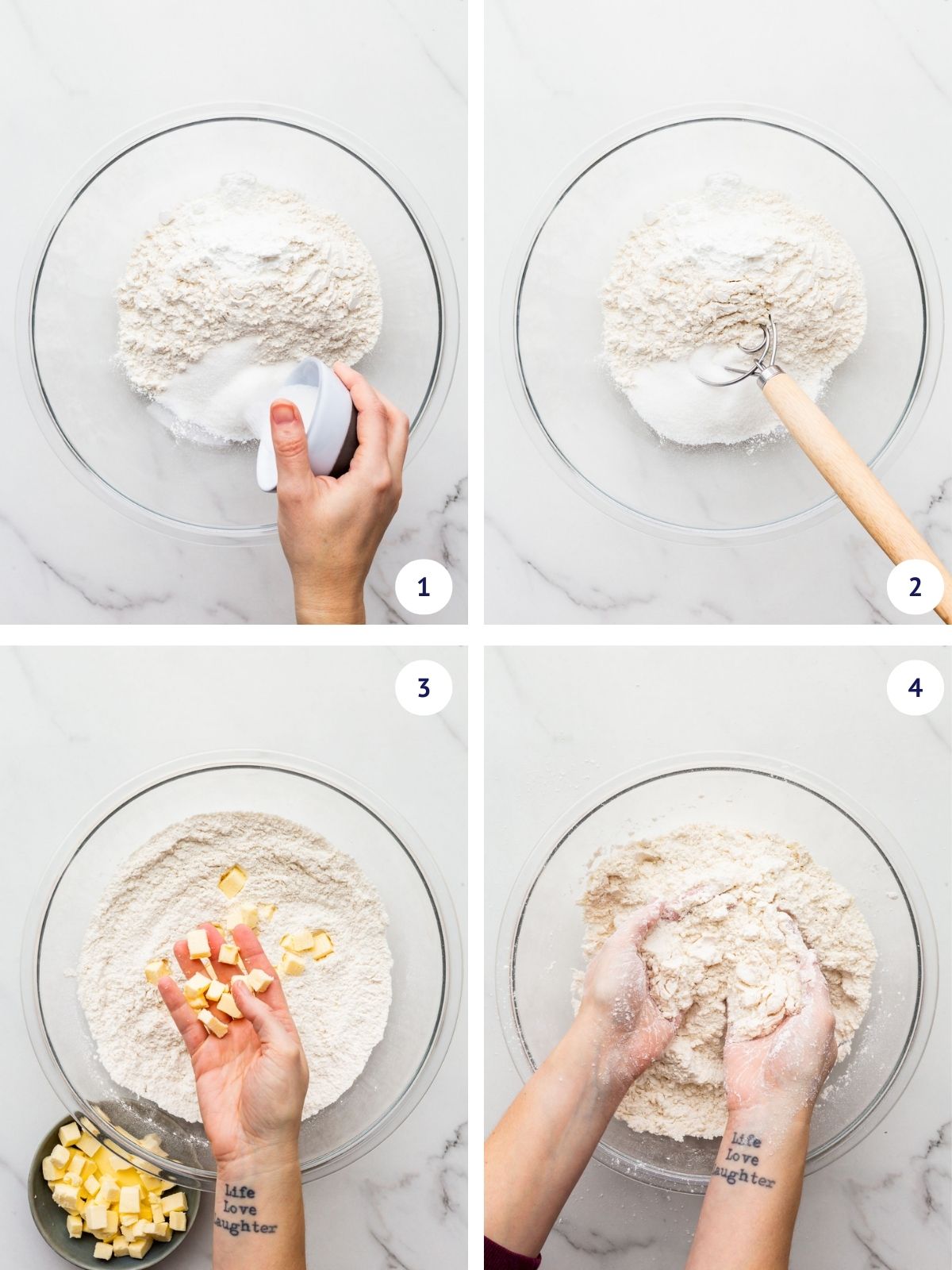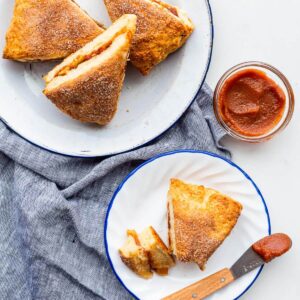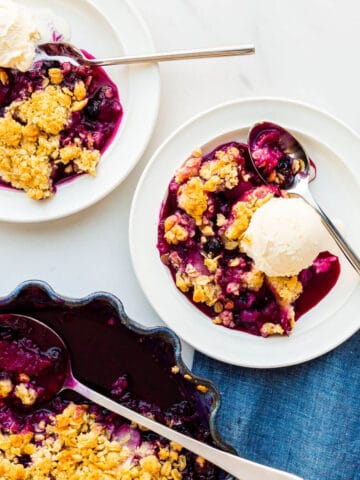Learn how to make the best apple cinnamon scones with this easy recipe. These delicious stuffed scones are made from a simple vanilla cream scone dough and filled with apple butter, chunks of fresh apple, and cinnamon sugar for a sweet apple breakfast treat.

You can easily incorporate fresh or frozen fruit or dried fruit into a scone dough, mixing it into the dry ingredients before you add the liquid (cream, buttermilk, or milk). For example, you can incorporate chopped rhubarb into your dry ingredients to make these cute little rhubarb scones, or chopped pear into these pear and chocolate scones.
For these apple cinnamon scones, we are using a different technique where the dough is stuffed with a delicious sweet filling.
Jump to:
Apple Cinnamon Scone Ingredients

- flour—I bake with bleached all-purpose flour, but unbleached would be fine here too.
- sugar—I used granulated sugar to avoid any molasses flavours to the scone dough.
- leavening—I made these scones with baking powder as the chemical leavening, not baking soda, since there aren't really any acidic ingredients in the dough to balance out baking soda. Read about baking soda versus baking powder if you aren't sure the difference between the two.
- salt—I bake with Diamond Crystal fine kosher salt. If using regular table salt, add half the amount listed in the recipe card.
- butter—use unsalted butter (diced and kept cold) or if using salted butter, reduce or omit the salt added to ensure the dough isn't overly salty
- egg—I always bake with large eggs, which weigh 56 grams with the shell on. If you use a different size of eggs, the dough may too dry or too wet.
- cream—you will need enough whipping cream (35 % fat) in the scone dough and also some to brush on top before baking
- vanilla—I bake with pure vanilla extract
- apple—for these stuffed apple pie scones, you will need both apple butter and fresh apple. Choose an apple variety that holds up to baking
- cinnamon—I made these scones with cinnamon sugar, rather than ground cinnamon to add some sweetness to the filling and topping since there isn't much sugar in the dough or the filling.
Please see the recipe card for the exact quantities and ingredients.
Substitutions and Variations
Your options for variations substitutions are limited, but here are a few suggestions:
- Scones without eggs: replace the egg with 60 mL (¼ cup) more cream. I do this quite often and it works great!
- Cinnamon sugar: if you don't want to make cinnamon sugar, just sprinkle generously the filling and dough with granulated sugar and cinnamon. Alternatively, you can garnish the tops of the scones with turbinado sugar before baking. This will give them a lovely crunch on the outside.
- Apple butter—I buy apple butter, but you could make it by cooking down apple sauce (or by making apple sauce and then boiling it down into a thick, dark spread). You could replace the apple and apple butter with apple jam.
- Apples—replace them with pear. You could even use canned pear. I prefer to buy canned pears in syrup because the taste is better. I used canned pears for these pear scones with chocolate.
Another option for the filling is to use a commercial apple pie filling instead of the combination of apple butter and diced apple. This would work fine, but personally I'm not a huge pan of canned apple pie filling from the grocery store, which can be somewhat gelatinous in texture.
Other Filling Ideas for Stuffed Scones
When I stuff scones, I like to combine a spread or preserve with some fruit. Here are a few ways you can change these up according to the seasons:
- jam—use homemade rhubarb jam (no pectin), plum jam, or spiced apple jam instead of the apple butter
- marmalade would make a great replacement for the apple butter, like this orange marmalade, grapefruit marmalade, or even three-fruit marmalade.
- spreads—try this homemade Nutella without hazelnuts or homemade maple butter
- fresh fruit, chopped apple, chopped pear, stone fruits, berries, etc
Mix and match these to see what you like. For a blueberry stuffed scone, I'd combine blueberry jam and fresh blueberries as the filling. Or make blueberry scones and stuff them with jam.
How to Make Stuffed Scones
These apple cinnamon scones are stuffed scones filled with apple butter, chopped apple and cinnamon sugar. Here's how to make them:

Step 1: Combine the dry ingredients with the sugar in a big mixing bowl (image 1), then use a Danish dough whisk to incorporate them (image 2) before dropping cubes of cold butter into the bowl (image 3) and working them in with your hands to make a coarse, uneven mixture (image 4)

Step 2: Once the butter is worked in, the mixture will resemble uneven bread crumbs (image 5). At this point, you can mix the wet ingredients in a separate bowl (preferably with a pouring spout), whisking together the cream, egg, and vanilla (image 6) before adding them to the bowl with the dry ingredients (image 7).

Step 3: Use the dough whisk to do as much of the mixing as you can (image 8), then I like to switch to a bowl scraper to do the last of the kneading (image 9).
Step 4: Divide the dough in two and place each piece on a rectangle of parchment paper (image 10), then pat out each into an 8-inch diameter circle using the palm of your hand to gently flatten it out (image 9).

Step 5: Spread apple butter on the surface of one disk of scone dough, leaving a ½ inch (1.3 cm) border (image 12). Scatter with apple chunks (image 13), then sprinkle cinnamon sugar over top (image 14). Top with the 2nd disk of dough (image 15).

Step 6: Brush the top of the scones with a little cream (image 16), then sprinkle with more cinnamon sugar (image 17). Cut into 8 scones using a bench scraper (image 18).

Step 7: Transfer the scones to a sheet pan (image 19) then bake until golden brown and baked in the middle (image 20).
Scone Baking Tip
If you do not separate the wedges at all and leave them as a disk after cutting (as above), there will be little to no airflow on the cut sides of the scones and the scones will take 10–20 minutes longer to bake through!
For faster baking, separate the wedges from each other to allow airflow between them for better heat distribution and to help them dry out a little on the edges, setting faster.
Scone FAQs
I always chill my homemade scones before baking them. Refrigeration will help the scones firm up and the butter will harden. This will slow the spread of the scones as they bake, ensuring that they hold their shape better as they bake!
The butter must be cold when you make scones. It can be either diced into small cubes or grated, and then chilled after cutting. Work with cold butter to ensure the dough stays cold to create a lighter, flakier texture. Warm butter will create a denser scone because the butter will melt into the dough more.
Remember, the key to making the best scones is to use cold ingredients: make sure the butter is very cold and the cream too. This way, your scones will be more tender, light and flaky, not heavy or greasy.
Some people swear by buttermilk to make moist, lighter scones. I swear by cream (35 % fat) because scones made with milk or buttermilk tend to dry out quickly.
Score scones in an airtight container for 3 days. Or freeze them for longer storage in a resealable freezer bag.
Other Recipes with Apple Butter
Looking for other recipes to bake with apple butter? You can make:
- apple butter pie, like a pumpkin pie but with apple butter
- apple butter cake with an oat streusel topping
- apple cupcakes made with apple butter and topped with the most delicious thick cream cheese frosting
If you tried this recipe for apple cinnamon scones (or any other recipe on my website), please leave a ⭐ star rating and let me know how it went in the comments below. I love hearing from you!
📖 Recipe

Apple Cinnamon Scones
Ingredients
- 375 grams bleached all-purpose flour
- 50 grams granulated sugar
- 15 mL baking powder
- 2.5 mL Diamond Crystal fine kosher salt
- 115 grams unsalted butter diced and kept cold
- 1 large egg(s)
- 250 mL whipping cream (35 % fat) plus more to brush on the scones before baking
- 5 mL pure vanilla extract
- 60 mL apple butter I used Filsinger or Eden brands
- 1 Cortland apple(s) cored and diced
- 15 mL cinnamon sugar plus more for garnishing the tops of teh scones before baking
Instructions
- In a large bowl, whisk together the flour, sugar, baking powder and salt.
- Drop in the cold, diced butter. With both hands, quickly pick up handfuls of the flour mixture and press/rub it all them together with your palms to work in the butter. This is called “sanding”. Continue sanding the flour until you obtain a fairly even mixture that resembles very coarse oatmeal or bread crumbs.
- In a small bowl, combine the cream, egg and vanilla. Whisk it together to break up the egg then pour the wet ingredients over the dry ingredients.
- Using a Danish dough whisk, stir the wet ingredients into the flour. When it’s all combined, give the mixture a last knead with your hands to ensure you've incorporated all the dry bits. Divide the dough in two.
- Pat out each half of the dough on parchment paper to about 8 inches in diameter.
- Spread the apple butter on the surface of one disk, and top with the chopped apple.
- Pat out the other half of the dough until it's also 8 inches in diameter.
- Place the second dough round on top of the first, pressing it down and gathering in the edges with your palms to tighten the edges and seal them together.
- Brush the round with cream and sprinkle with cinnamon sugar. Cut into eight large wedges. Freeze for 15 minutes while you preheat the oven.
- Preheat the oven to 400 °F (200 °C).
- Transfer the wedges onto a parchment-lined baking sheet, staggering them, and bake for about 30–40 minutes, until the edges are golden brown.
- Let the scones cool for about 10 minutes to firm up. Serve warm with more apple butter.
Notes
- If you prefer to make your scone dough without eggs, replace the egg with 60 mL (¼ cup of cream). This means that in total for this recipe, you would measure out 310 mL (1-¼ cups) of cream.
- I used store-bought apple butter, but you can also make it by cooking down apple sauce until it is thick and dark and most of the water has evaporated.
- If you don't have apples, you can use fresh or canned pear. I love to use canned pears in syrup specifically. The flavour is better. Blot them dry before using them.
- You can make a big batch of cinnamon sugar to use in your recipes. Or you can replace it with a combination of granulated sugar and ground cinnamon. You can sprinkle the tops of the scone with crunchy turbinado sugar if you prefer.






Charlotte says
As an outsider to the moth situation, I have to say that I found your account pretty darn funny. But if I had to live through it, I'd be pissed. Good luck with the tupperware bins, sweaters, and scones!
Janice Lawandi says
It's true. In the moment it was all pretty terrible, but now looking back, it's rather hilarious 😉
Thanks for reading!
Yes Cook says
Love apples and love scones.. delicious.
Janice Lawandi says
Thanks for stopping by! Hope you get to try them sometime soon!
Yes Cook says
I sure will try them. Thanks.
Melissa says
Haha! When my wasp guy came he was all "are we doing this the organic way or the other way?" And I was all "I don't care... I want them all dead dead dead and outta my house" needless to say, we didn't go organic. Don't mess with the little buggers!
Janice Lawandi says
I'm very tempted, but moth balls smell so nasty, and I read somewhere that fumigating doesn't really work with moths (which really worries me because I'm not sure how my vacuuming is going to top fumigating?).
Janice Lawandi says
Oh man, wasps = way worse. At least moths don't bite. I guess I'm "lucky" in the grand scheme of bug problems 😉
Medeja says
These look and sound like perfect scones for me! 😀
Janice Lawandi says
You should definitely give them a try 😉